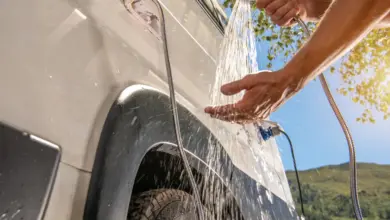How To Choose Crampons: The Ultimate Guide
How To Choose Crampons
For climbing steep icy areas or crossing open summits, crampons will be necessary. If you are doing lighter winter travel, other traction devices such as Microspikes may be better suited. Before you go out and buy crampons, make sure you know how to choose the right crampons for you.
Depending on what activity you are doing, you’ll want crampons to best suit your needs. Crampons are becoming more specialized for different tasks, such as walking, glacier travel, technical hiking, and mountaineering. Generally speaking, the more technical the activity, the more rigid and greater the number of points the crampon will have.
Crampon Features
There are several features to consider when purchasing crampons, such as the type of material, weight, construction, type of binding, and points. Let’s take a closer look at these crampon features.
Type of Material
There are three types of materials crampon points are made out of:
Steel crampons: These are best for general mountaineering. They are durable and are good for technical, steep, and icy terrain.
Stainless-steel crampons: Stainless steel generally doesn’t rust and still offers the benefits of steel crampons.
Aluminum crampons: These are lighter than steel which offers an advantage for alpine climbs. They do wear out quicker, so they are ideal for approaches and ski mountaineering. If you use them on rocky terrain, they won’t last as long.
Construction
Virtually all crampons on the market today are of a semi-rigid design. In the older days, there would be a “rigid” and “hinged” type frame. On rigid frames, there would be no movable parts, making the frame rigid. On hinged-style frames, the front and back would be connected with a hinge, allowing for greater flexibility when walking. Today, there are semi-rigid design that offers enough flexibility for walking, yet is rigid enough for more technical climbing.
On some crampons, modifications can be made to the linking bar to change the crampon from a semi-rigid design to a more flexible one. This is useful to make walking more comfortable and less likely to collect snow underneath.
You may also like Can You Hike in Doc Martens?
Types of Bindings
Most boots will accept crampons, but it’s nice to be sure. If you wear overboots, keep in mind sizing. Overboots tend to be thicker with extra rubber and fabric, which will affect the fit. There are three types of crampon bindings: Step-in, strap-on, and hybrid.
Step-In
Step-in bindings are the most sturdy of all bindings. They work well for technical activities such as vertical climbing and can work for glacier walking or hiking, but they may be a little more uncomfortable. One thing to consider is that step-in bindings work with only certain boots. For this type of binding, you’ll want boots that have rigid soles and at least a 3/8th” groove on the heel and toe. Think ski and mountaineering boots.
The boots should have little flex. If the boot has too much flex, the binding is more likely to pop out. Another thing to be aware of is that step-in bindings may be difficult to snap to your boots if the boots are covered in ice or snow.
Strap-On
Strap-on bindings are the most versatile type of crampon, meaning they can be attached to nearly any kind of boot. These bindings can take some extra time to put on, but their versatility is worth it. If you have multiple pairs of boots, a single pair of strap-on crampons could attach to all of them. One thing to keep in mind is to make sure the center bar of the crampon is compatible with the flex of your boot. While these bindings are good for moderate climbing, there may be some slight wiggle room or vibration between the boot and the crampon.
Hybrid Bindings
Hybrid bindings are a combination of step-in and strap-on bindings. They are sometimes called “mixed” or “semi-step” crampons. These bindings work with boots with a heel groove but don’t require one on the toe. These can be easy to attach to the boot even when wearing gloves.
You may also like Are Winter Boots Waterproof? It Depends
Points
Number of Points
Most crampons have 10 or 12 points. You want the points to be in the right place (under your instep and following the shape of the boot). You might need to adjust the front bails of the crampon to get the correct point extension. Nowadays, a few highly technical models have points with serrated sides allowing the crampons to grab even in places where a point doesn’t penetrate the snow or ice.
As a crampon’s end-use transitions from winter walking and mountaineering to overhanging mixed routes, its number of points (and rigidity) increases.
- Most 10-point crampons are ideal for ski touring and glacier travel. You can use these to climb volcanoes or traverse the Haute Route.
- Crampons for technical ice and mixed climbing have more aggressive front points that are often adjustable and replaceable. These waterfall-specific crampons sometimes allow you to change the length of the front points on the body itself.
Waterfall-specific crampons allow front points to be configured as dual-point, monoprint, or monoprint offsets. Sometimes climbers change the droop angle of their crampons, with steeper droops set for dry tooling, when pulling in with the feet is necessary (like with climbing slippers on overhangs).
For general mountaineering, it is easier to walk with less frontpoint sticking out. For technical climbing, you’ll want longer points. Most step-in technical crampons have different front bail positions, so you can adjust the toe position according to whether you are walking or climbing.
Front points
This refers to the forward-facing points (or points) on crampons:
Horizontal: These dual points are suitable for almost any alpine climbing or ice/snow climbing.
Vertical: These dual points are preferred for steep waterfalls and mixed climbs. These front points slip easily into cracks and are adjustable and replaceable. Some technical-ice crampons have secondary front points for added support and traction.
Monopoint: This single point is popular for technical waterfall and mixed climbing. The specific demands of a technical waterfall or mixed alpine route (as well as the conditions) often dictate the type of crampon that’s best suited for the task.
Modular vs. Non-Modular
Points are either modular (adjustable) or non-modular (fixed).
- With modular front points, you can replace the teeth or reconfigure them to support the type of walking or climbing you have planned. If you are doing a lot of mixed rock-and-ice climbing and think you’ll need to replace your points eventually, get modular crampons.
- While non-modular points can be sharpened, they get shorter with wear. These one-piece forged marvels tend to be lighter than their non-modular cousins. Also, since there are no moving parts, you don’t have to worry about screws coming loose.
You may also like Military Boots for Hiking (Tips and Recommendations)
Crampon/Boot Compatibility
Boot and crampon compatibility are essential for performance and safety. Your boot type ultimately tells you what options you have in binding systems. For example, ultralight strap-on crampons will work on ultralight hiking boots, but they are not suitable for mountaineering or ice climbing. A crampon strapped to a flexible-soled boot will not fit as securely as on a rigid-soled boot. Some considerations:
Determine what type of boot you have. Is the sole highly flexible, semi-flexible, or rigid? Does it have toe or heel welts, or both? If you have highly flexible boots without toe welts, you may need a new boot if you are planning to wear them with technical climbing crampons.
What activities are you planning? For mountaineering or ice climbing, look at the toe and heel of your boot. You have several crampon binding options. For walking rather than climbing, consider less technical crampons with a strap-on binding. If you want step-in crampons, keep in mind you need stiff-soled boots with thick welts or grooves at the toe and heel.
Match the flexibility of your footwear with the flexibility of the crampon. For highly flexible boots, get crampons with a flexible center bar that connects the front and back. You can wear aluminum crampons with sneakers (and strap-on bindings) for light mountaineering or glacier travel, just make sure the flexibility is similar.
Bring along your boots when shopping. This is a smart way to make sure a crampon fits. Make sure the center bar fits the boot for flex, shape, and length. Climbers often make micro-adjustments, like adjusting the toe bail, to secure a seamless fit.
When in doubt, go with a strap-on system. This fits most footwear best, and it’s always better to err on the side of getting a crampon that fits!
Crampon Accessories
Anti-balling plates: All crampons come with an anti-balling plate (usually made of ABS plastic) to prevent snow from sticking to the bottom of the crampon. This is important to keep you from losing traction. Anti-balling systems are highly recommended by the UIAA (the International Mountaineering and Climbing Federation).
Crampon cases and point covers: Protect your pack and yourself from sharp crampon points with rubber point covers or a crampon case which is typically made of rugged, puncture-resistant nylon. Cases make for quick and easy storage; rubber point covers are less bulky and less expensive.
Gaiters: In addition to a crampon case, consider a sturdy pair of gaiters to protect your lower legs and apparel from getting nicked by sharp crampon points.
Spare parts: You can buy alternative center bars for most crampons. These bars can make the crampon more or less flexible, or allow you to extend a crampon to fit bigger boots. If traveling to a remote area, it’s a good idea to bring along extra toe and heel bails, screws, and center bar.
Photo credit: simonov on VisualHunt.com / CC BY-SA



